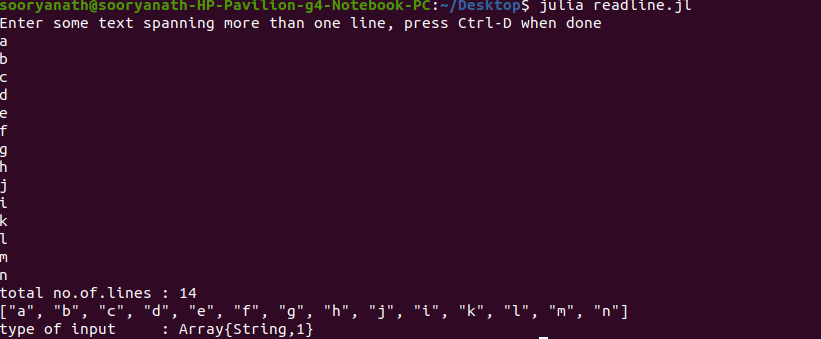读取用户输入是程序与用户之间的一种交互方式。在测试具有不同合法输入的一段代码的情况下,用户输入是必要的。
从 Julia 的控制台读取用户输入可以通过内置的 I/O 方法完成,例如:
- 阅读线()
- 阅读线()
使用 readline()函数
readline()方法从输入流 (STDIN) 读取一行文本,直到遇到“\n”(换行符)字符。输入作为字符串数据读取。
句法:
s = readline()
示例 1:
在下面的示例中,使用readline()方法获取用户输入。我们可以先在打印语句的帮助下提示用户。需要注意的是,readline 方法将输入读取为字符串数据类型。
# Julia program to take input from user
# prompt to input
print("What's your name ? \n\n")
# Calling rdeadline() function
name = readline()
println("The name is ", name)
print("\n\n")
# typeof() determines the datatype.
println("Type of the input is: ", typeof(name))
输出 :

示例 2:从控制台读取数字数据类型
下面的示例演示了如何将输入读取为数字并在进一步计算中使用它们。这是使用parse()方法完成的,我们可以使用该方法将数字字符串(Float 或 Int)转换为数值。
# Julia program to calculate sum of
# 5 integers obtained from console/user input
result = 0
# Prompt to enter
println("Enter 5 numbers line by line")
# Taking Input from user
for number in 1:5
num = readline()
num = parse(Int64, num)
global result+= num
end
println("The sum is :", result)
输出: 
使用 readlines()函数
readlines()方法用于从控制台读取 N 行文本输入。 N 行存储为一维字符串数组的条目。这行必须以字符或按“ENTER”键进行分隔。要停止输入,请按 Ctrl-D。
句法:
lines = readlines()
示例 1:从 STDIN 读取 N 行输入
在下面的示例中,N 行输入被获取并存储在一维字符串数组中。我们可以使用它的索引访问所需的行。
# Julia program to take
# multi-lined input from user
line_count = 0
println("Enter multi-lined text, press Ctrl-D when done")
# Calling readlines() function
lines = readlines()
# Loop to count lines
for line in lines
global line_count += 1
end
println("total no.of.lines : ", line_count)
println(lines)
# Getting type of Input values
println("type of input: ", typeof(lines))
输出:

示例 2
在下面的示例中,我们输入 N 行并通过添加条目编号作为前缀来显示条目。
line_number = 1
println("Enter few paragraphs")
print("\n")
lines = readlines()
println()
for line in lines
println(line_number, ". ", line)
global line_number += 1
end
输出:
